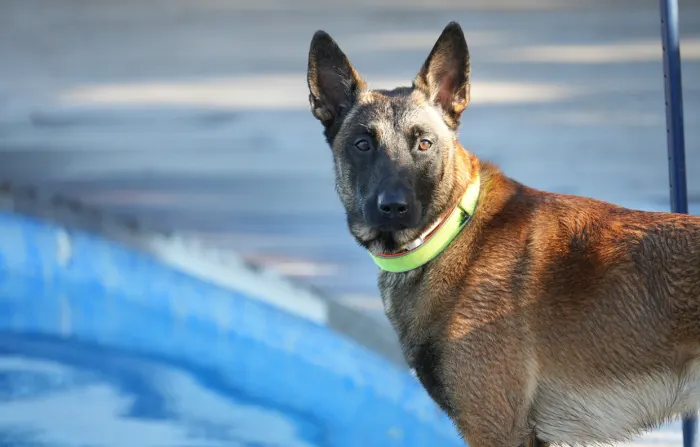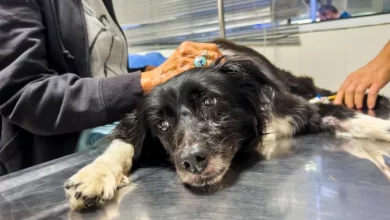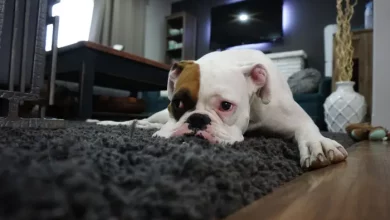Why Does My Dog Freak Out When I Go in the Pool?

You are not the only one if your dog panics when you get in the swimming pool. The dogs may perceive us in the collection differently than we do. Their instincts can take over, leading to a state of panic.
What exactly does “freaking out” mean for a dog? It’s tempting for humans to attribute human emotions to our dogs and to use labels to describe the behaviors.
Depending on who you talk to, a dog “freaking” out can mean different things. The term “freaking” is used in this article to describe:
Dogs whine or bark when someone goes into the swimming pool. Dogs that pace around the pool when you are there. (Sometimes to the point where they injure their paw pads). Dogs that pant and shake when other people are present.
You may be desperate to find a solution if your dog starts barking, whining, and pacing the minute you or another family member enters the pool.
It can be challenging to solve these cases because our dogs would love to join us at the pool. Even if they are kept inside, they will still bark and become frustrated by being left alone. Nothing works!
There are no quick fixes for dogs. The best solution is to invest time and focus on managing your dog.

Why does my dog “freak out” when I enter the pool?
Dogs may react in several ways when their owners get into the swimming pool.
Consider that each dog is unique and may react differently to the presence of people in a pool. Here are a few possible reasons.
- Your dog wants to join you.
When your dog sees you swimming in the pool, he may want to join you.
He may want to jump in but is scared to do so. Or he might need to find out if it’s okay and ask for permission.
He perceives the water in the pool as a barrier, which prevents him from participating in your fun.
Some dogs enjoy being in the pool but are hesitant to jump into it because they have a nagging fear.
They may feel unsafe if they do not know how to quickly get out of a pool.
Recommended for You
The last steps are also underwater, and the dogs can’t see them.
Dogs can become frustrated when they are unable to accomplish a task. They may pace, whine, and bark.
- Your Dog Has Separation Anxiety
Does your dog follow you around and can’t stand being left alone at home? Does it bark and whine when you close the door to the bathroom?
Your dog could be displaying signs of separation distress.
Some dogs can struggle to be near their owners, even when they are within sight. However, they cannot be glued.
These dogs can show signs of distress when their owners are in the swimming pool because they cannot stick by their side.
- Your dog is worried about you.
Your dog’s behavior could be due to his fear of water. If he is afraid of the water or struggles to understand your actions in the pool when you are there, he may be worried about you.
Some dogs have difficulty understanding why we jump in the pool. Your dog might think that they are in danger if there are children playing in the water and screaming.
Then they may grab our hands and try to pull us away. Their teeth can cause lacerations on our skin.
- Your dog doesn’t understand what’s happening.
When something strange happens, some dogs get anxious and can’t comprehend it.
When my mother fell asleep with her lips open, she growled at my sweet Rottweiler. She must have found it very strange!
I’ve seen dogs get anxious when their owners do something new, such as ride a bicycle for the first, dance, put on a hat, go to the gym, push a stroller, or use an umbrella.
They don’t understand that we are swimming to stay afloat. They see us flapping our legs and arms in an unusual way.
Our pool time may cause them to become anxious, causing them to whine, bark, and pace.
- Playing with Herding Instincts
Dogs that pace and bark are often herding dogs (corgis), Australian shepherds or German Shepherds, Border Collies, and Belgian Malinois.
They were bred to round up cattle or sheep. They are trained to control animals that run amok and maintain a certain degree of law and order.
These dogs will bark, try to control their movements, and run around when there are many people, particularly children, in the pool. Intrigued? Discover more about herding behaviors in dogs.
This is not a fear reaction but rather a state of over-arousal/excitement that occurs when people jump into a swimming pool.
Did you know?
Some dogs may become obsessed with the sport of swimming. I’ve seen dogs that swim continuously seven hours per day. “They whimper all the time because they cannot stop, even though they are unbelievably exhausted,” says Dr. Nicholas Dodman, a board-certified veterinarian behaviorist.
How to stop a dog from barking when going in the pool?
We’ve all seen how dogs get frightened when there are people in the pool. If you want to change the behavior, it’s important to address the cause. Here are some tips to help you:
- Avoid Rehearsing Problematic Behavior
The most important step is to stop your dog from performing the problem behavior.
As your dog continues to engage in barking, whining, and pacing, these behaviors will become more ingrained and develop into habits.
- Give your dog something else to do
If your dog is anxious, try giving him something to chew on that will keep them busy (like a frozen Kong with kibble and canned dog food) while you are in the swimming pool.
Be sure that the people are calm. They should not scream or splash. When your dog has finished chewing the water, get the people out and call it quits. Repeat this several times in order to establish a routine.
What can I do if my dog won’t eat?
Many dogs will not be able to eat or use food puzzles when there are people in the pool because they’re so upset and anxious.
When your dog refuses to eat, it could be a sign that he is “over the threshold.” In this condition, dogs lose their appetite and are unable to function cognitively.
You will need to first identify the exact problem your dog has before you can begin implementing behavior modification strategies.
- Identify the Trigger
If your dog becomes frightened when you or others enter the swimming pool, consider what may be causing his problem behaviors.
Is your dog agitated when there are people splashing in the water? Does he get upset when children scream? Does he act up as soon as people enter the swimming pool? Does your dog mind if people use a floating device in the pool?
You can then focus on the areas that are most important. Consider that dogs can initially become frightened by the sound of screams or splashes. However, their anxiety will then spread to include the mere presence of people in the pool.
This is similar to separation anxiety. Initially, the dog may be upset when they realize that its owners have left and are alone. Then, as they get older and as their owners prepare to leave for work, the dogs start to panic.
- You can desensitize your dog to his triggers and counter-condition him.
Desensitization is a method of behavior modification that involves exposing dogs to triggers at a lower intensity level.
Dogs can better manage their triggers with low-intensity exposures while remaining below the threshold.
The counterconditioning method is a way to modify behavior by creating positive associations.
Treats can be used strategically to create positive associations. This method is most effective when combined with desensitization.
Example of Behavior Modification
Here are some examples of general behavior modification.
Each dog will require a different plan based on a variety of factors (such as the level of anxiety displayed or the type of triggers that cause the behavior).
Dogs with Splashes
If your dog is afraid of people splashing in the pool, for example, you can start by keeping him away from the water and having him watch as a person places an arm into the water while feeding him tasty treats.
After he is comfortable with this, you can move on to having the person move the arm underwater a little while still feeding him treats.
Then, progress to a person who splashes the water a little bit and then more. (While always giving treats).
The person can then start by placing one leg in the water, and performing the same exercise. You get the picture.
It is important to gradually and consistently get the dog used to the sight of the person swimming and splashing. Aim for a lovely, positive emotional response.
Canines that have trouble seeing people in the pool
Start this exercise inside if your window overlooks the swimming pool or if your dog is scared of people in the water.
Your dog can observe the swimmer while on a leash if he is safe from the window.
Use Leslie McDevitt’s Look at That Game to have him look at the person, and then feed him treats each time he does.
It is essential to teach him to be calm so that he can watch someone outside (while on leash) and eventually go off-leash and remain calm while looking for treats.
Dogs Struggling with Children Screaming
You can begin indoors. Have your dog leash and a child go into the pool.
Treat your dog with tasty treats when the child splashes in the water (using the exercise above), then for screaming loudly at first and then at a lower volume.
As your dog improves, you can add more children to the pool.
When Should You Take A Step Back and When Should You Raise the Criteria?
It’s crucial that if the dog struggles at any point with these exposures, you take a break and focus on making the vulnerabilities less intense.
You can increase the intensity of your dog’s training when it consistently performs well. Always look for any signs of stress in your dog’s body.
- Train an alternate behavior.
You can teach your dog a new behavior to keep him occupied and happy once calmer.
You can teach him to catch balls you throw at him and then have him drop the balls in the pool for you to toss again.
Play is not compatible with fear. This can help your dog to understand that there is no danger and that you are all having fun!
If your dog is comfortable in the water and knows how to swim, you can teach him to lie down and ride a durable dog pool float.
You can also have your dog “fetch” treats from a remote dispenser of treats or bubbles using a bubble machine for dogs. This is great for dogs that love to herd. These bubbles have a bacon flavor for your dog to enjoy.
You can train your dog by randomly aiming a stick at a random location and rewarding him with treats when he does so.
- Manage Your Time When You Can’t Get to Work
If you cannot deal with the issue, or if the situation is too overwhelming (such as a large pool party), then it’s better to handle the situation to prevent your dog from repeating the bad behavior.
If you plan to use the pool or have guests come over and enjoy it, you can ask a family member to walk your dog.
The content of this page is accurate to the author’s best knowledge and does not replace formal, individualized advice given by a qualified professional.




